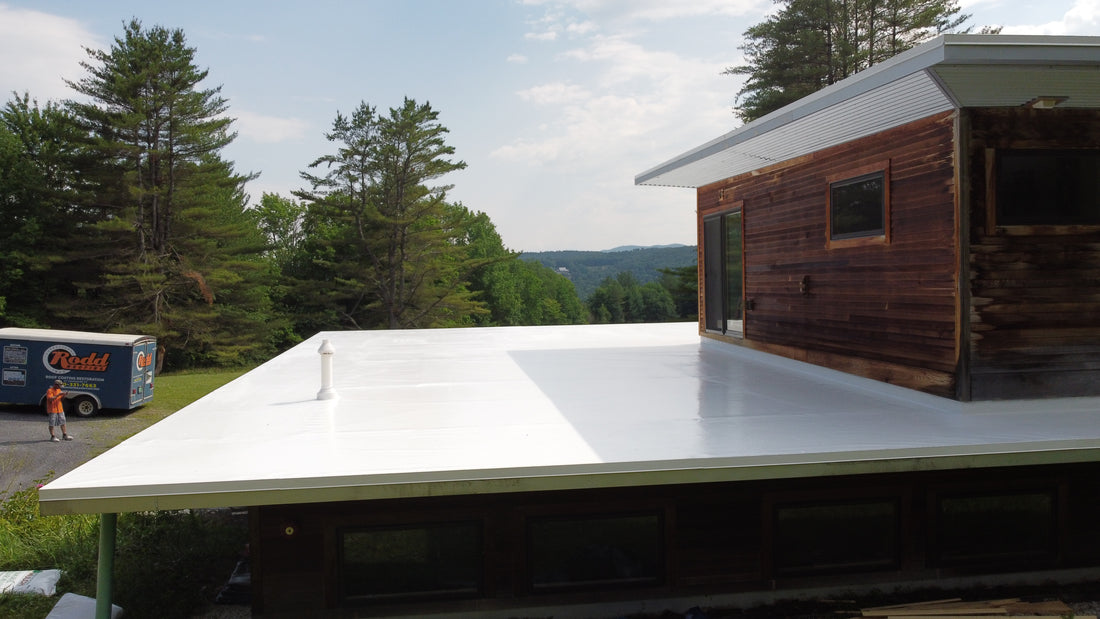Which is Better: Silicone vs. Acrylic?
If you plan to restore your home’s flat roof or RV roof, silicone or acrylic coatings could be on your shopping list. But which one is superior? This week’s blog will look at silicone vs. acrylic coatings and answer the question, “Which is Better?”
Ponding water
One of silicone’s biggest advantages over acrylic is that it’s an inorganic coating. That means it’s not water-based and therefore will not break down under ponding water. Silicone can hold water for long periods of time without suffering any corrosion or degradation.
On the other hand, acrylic coatings are organic, meaning they will break down under ponding water. Once that acrylic breaks down, water can leak into your roof structure. That can further damage your roof structure and the home or RV it is covering.

That means organic (acrylic) coatings are not a great option for a flat or low-slope roof. Acrylics can, however. be used on steep-slope metal roofs where ponding water is not an issue.
Cost
Acrylic is usually the cheaper coating in terms of raw materials. Acrylic supporters often cite this as its No. 1 advantage. Front-end cost isn’t the full story, however. For example, a customer’s costs will increase as acrylics typically require two coats. That means double the labor time and material it would take compared to a silicone installation.
Silicone, meanwhile, can provide financial benefits long after it’s applied. White silicone roof coatings on a home can reflect up to 88% of the sun’s harmful UV rays. That, in turn, lowers the home’s internal temperature and provides cost savings for the homeowner through lower air-conditioner use.
Additionally, silicone’s elasticity allows the coating to expand and contract during changing seasons and weather conditions. That keeps your roof protection in place longer.
Thickness Levels
Anything that’s outside will eventually degrade because of age and weather conditions. But in the roof coating business, silicone has been proven to last much longer than acrylics.
Major commercial roofing contractor West Roofing Systems said it has NEVER seen a silicone coating wear completely on roofs with a 15-year warranty. They have all lasted longer, especially if yearly maintenance has been performed.
Acrylic systems, meanwhile, tend to lose more of their thickness as a result of constant weathering and other exposure to environmental conditions.
Installation

Another issue to consider is installation and whether silicone or acrylic coatings are easier to put on your roof.
We noted earlier that acrylic coatings are water-based, and that means they can only be installed in good weather. Excessive humidity or extreme temperatures can jeopardize the installation of an acrylic roof coating. For an acrylic coating to adhere to the roof, the temperature must be at least 50 degrees.
Silicone coatings cannot be applied in the rain – neither can acrylics. But silicone has a much wider application window. If you can withstand the cold and stay on the roof, silicone can probably still be applied.
Conclusion
When you are looking at silicone vs. acrylic coatings for your next DIY project on your home or RV, we believe the answer is easy. Silicone’s superior waterproofing and durability cannot be matched by acrylic coatings.
Acrylics can offer a quick fix on a sloped roof, but silicone is far superior when comparing longevity, durability, and ease of application. For any building with a flat or low-slope roof, silicone is really the only option you should consider.
Thank you for reading. For more information on Countryman’s silicone roof coatings, you can contact us here.


